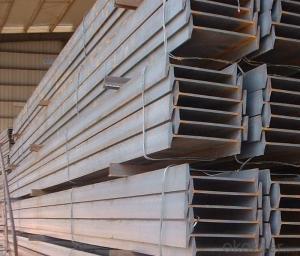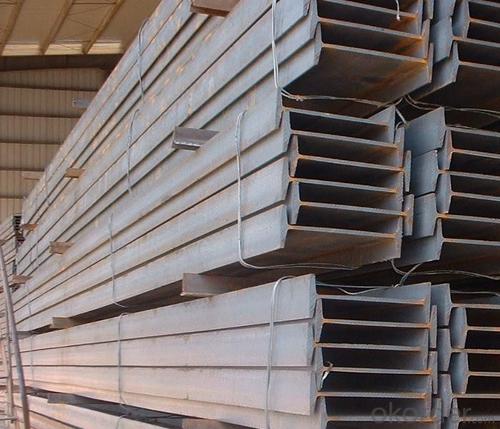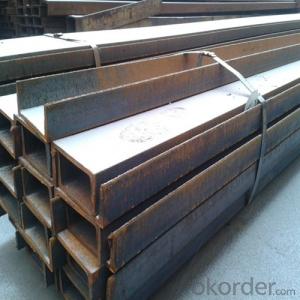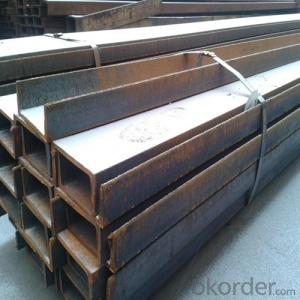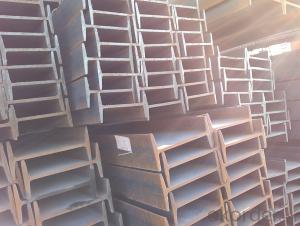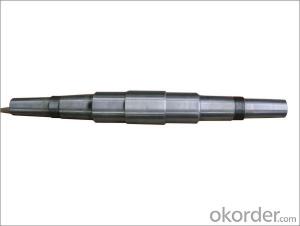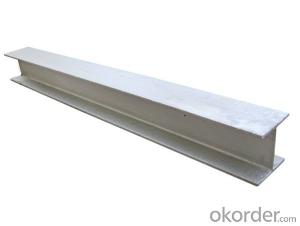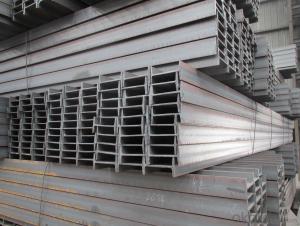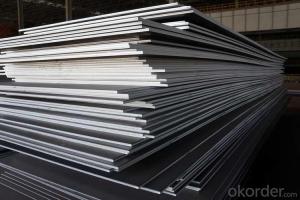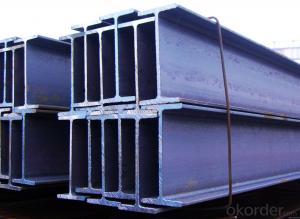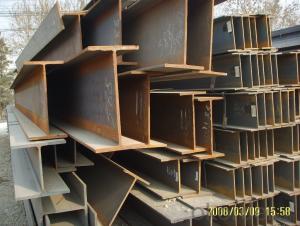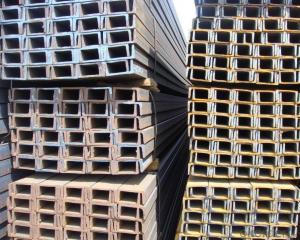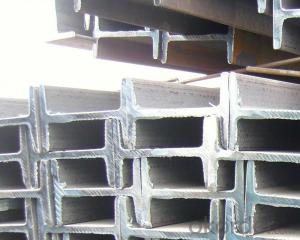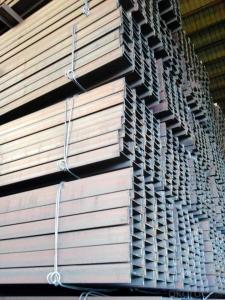Hot Rolled I Beam Steel IPE
- Loading Port:
- China Main Port
- Payment Terms:
- TT or LC
- Min Order Qty:
- -
- Supply Capability:
- -
OKorder Service Pledge
OKorder Financial Service
You Might Also Like
Product Description:
OKorder is offering Hot Rolled I Beam Steel IPE at great prices with worldwide shipping. Our supplier is a world-class manufacturer of steel, with our products utilized the world over. OKorder annually supplies products to European, North American and Asian markets. We provide quotations within 24 hours of receiving an inquiry and guarantee competitive prices.
Product Applications:
Hot Rolled I Beam Steel IPEare ideal for structural applications and are widely used in the construction of buildings and bridges, and the manufacturing, petrochemical, and transportation industries.
Product Advantages:
OKorder's Hot Rolled I Beam Steel IPE are durable, strong, and resist corrosion.
Main Product Features:
· Premium quality
· Prompt delivery & seaworthy packing (30 days after receiving deposit)
· Corrosion resistance
· Can be recycled and reused
· Mill test certification
· Professional Service
· Competitive pricing
Product Specifications:
Manufacture: Hot rolled
Grade: Q195 – 235
Certificates: ISO, SGS, BV, CIQ
Length: 6m – 12m, as per customer request
Packaging: Export packing, nude packing, bundled
Chinese Standard (H*W*T) | Weight (Kg/m) | 6m (pcs/ton) | Light I (H*W*T) | Weight (Kg/m) | 6m (pcs/ton) | Light II (H*W*T) | Weight (Kg/m) | 6M |
100*68*4.5 | 11.261 | 14.8 | 100*66*4.3 | 10.13 | 16.4 | 100*64*4 | 8.45 | 19.7 |
120*74*5.0 | 13.987 | 11.9 | 120*72*4.8 | 12.59 | 13.2 | 120*70*4.5 | 10.49 | 15.8 |
140*80*5.5 | 16.89 | 9.8 | 140*78*5.3 | 15.2 | 10.9 | 140*76*5 | 12.67 | 13.1 |
160*88*6 | 20.513 | 8.1 | 160*86*5.8 | 18.46 | 9 | 160*84*5.5 | 15.38 | 10.8 |
180*94*6.5 | 24.143 | 6.9 | 180*92*6.3 | 21.73 | 7.6 | 180*90*6 | 18.11 | 9.2 |
200*100*7 | 27.929 | 5.9 | 200*98*6.8 | 25.14 | 6.6 | 200*96*6.5 | 20.95 | 7.9 |
220*110*7.5 | 33.07 | 5 | 220*108*7.3 | 29.76 | 5.6 | 220*106*7 | 24.8 | 6.7 |
250*116*8 | 38.105 | 4.3 | 250*114*7.8 | 34.29 | 4.8 | 250*112*7.5 | 28.58 | 5.8 |
280*122*8.5 | 43.492 | 3.8 | 280*120*8.2 | 39.14 | 4.2 | 280*120*8 | 36.97 | 4.5 |
300*126*9 | 48.084 | 3.4 | 300*124*9.2 | 43.28 | 3.8 | 300*124*8.5 | 40.87 | 4 |
320*130*9.5 | 52.717 | 3.1 | 320*127*9.2 | 48.5 | 3.4 | |||
360*136*10 | 60.037 | 2.7 | 360*132*9.5 | 55.23 | 3 |
FAQ:
Q1: Why buy Materials & Equipment from OKorder.com?
A1: All products offered byOKorder.com are carefully selected from China's most reliable manufacturing enterprises. Through its ISO certifications, OKorder.com adheres to the highest standards and a commitment to supply chain safety and customer satisfaction.
Q2: How do we guarantee the quality of our products?
A2: We have established an advanced quality management system which conducts strict quality tests at every step, from raw materials to the final product. At the same time, we provide extensive follow-up service assurances as required.
Q3: How soon can we receive the product after purchase?
A3: Within three days of placing an order, we will begin production. The specific shipping date is dependent upon international and government factors, but is typically 7 to 10 workdays.
Q4: What makes stainless steel stainless?
A4: Stainless steel must contain at least 10.5 % chromium. It is this element that reacts with the oxygen in the air to form a complex chrome-oxide surface layer that is invisible but strong enough to prevent further oxygen from "staining" (rusting) the surface. Higher levels of chromium and the addition of other alloying elements such as nickel and molybdenum enhance this surface layer and improve the corrosion resistance of the stainless material.
Q5: Can stainless steel rust?
A5: Stainless does not "rust" as you think of regular steel rusting with a red oxide on the surface that flakes off. If you see red rust it is probably due to some iron particles that have contaminated the surface of the stainless steel and it is these iron particles that are rusting. Look at the source of the rusting and see if you can remove it from the surface.
Images:

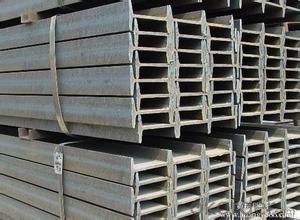
- Q: Can steel I-beams be used for swimming pool construction?
- Steel I-beams can be used in swimming pool construction, but it is not a common choice. Steel I-beams are typically used for structural support in buildings and bridges, and while they can provide a strong framework for a swimming pool, there are some factors to consider. Firstly, steel I-beams may require additional corrosion protection. Swimming pools are filled with water and chemicals, which can cause corrosion over time. Therefore, proper coating or protection measures should be taken to prevent rust and deterioration. Secondly, steel I-beams may not be as aesthetically pleasing as other materials commonly used in swimming pools, such as concrete or fiberglass. If aesthetics are an important factor, alternative construction materials might be more appropriate. Lastly, steel I-beams can be more expensive than other construction materials used in swimming pools. Depending on the project budget, it may be more cost-effective to choose a different material. In summary, while steel I-beams can be used for swimming pool construction, there are practical considerations to take into account such as corrosion protection, aesthetics, and budget.
- Q: I want to use a lever beam point, two meters away from the middle of the fulcrum, to lift two tons half the weight of I-beam with much?
- Your problem is the most basic cantilever beam. There is a whole formula in the mechanics of the material. The formula is not written to you. In the Baidu library, look for the mechanics of the PDF book and see the part of the calculation by yourself. You give something incomplete, so you have a cantilever beam, the most basic pivot distance from both ends of the length, you gave one. What material do you use, don't you say?. The use of low alloy steel or carbon structural steel, or stainless steel, is unknown.
- Q: Can steel I-beams be used for green or sustainable building projects?
- Yes, steel I-beams can be used for green or sustainable building projects. Steel is highly recyclable, and using recycled steel in the construction of I-beams can significantly reduce the environmental impact of a building project. Additionally, steel is a durable material with a long lifespan, meaning that structures made with steel I-beams can last for decades, reducing the need for frequent repairs and replacements. Moreover, steel I-beams are incredibly strong and can support large loads, allowing for more flexible and efficient designs that can optimize space and energy usage. Lastly, steel is fire-resistant, which can enhance the safety and resilience of a building. Overall, incorporating steel I-beams in green or sustainable building projects can contribute to reducing carbon emissions, conserving resources, and creating more environmentally friendly and energy-efficient structures.
- Q: What are the different types of connections used for steel I-beams?
- Steel I-beams can be connected using different types of connections, which vary depending on the specific application and structural requirements. Some common connection types include: 1. The most commonly used connection for steel I-beams is welding. This involves welding the I-beam to a connection plate or another beam to create a strong and durable joint. 2. Another widely used method is bolted connections. These connections involve using bolts and nuts to fasten the beams together. Bolted connections offer the advantage of easy adjustment or dismantling if necessary, making them a flexible option. 3. Riveted connections, although less common nowadays, were historically used. This method involves using metal pins with a formed head on one end, called rivets, to connect the I-beams. Riveted connections provide high strength and durability. 4. Pinned connections allow for rotational movement between the connected beams. This type of connection is often used in structures that require flexibility, such as bridges or seismic-resistant buildings. Pinned connections typically use pins or bearings to enable rotation. 5. Moment connections are designed to transfer both vertical and horizontal loads between beams. These connections are used in structures that require a rigid connection to resist bending moments. Moment connections can be achieved through welding or bolting and provide high strength and stability. It is important to consider factors such as load requirements, structural design, and construction methods when choosing a connection type. Consulting with a structural engineer or qualified professional is crucial to ensure the appropriate connection type is chosen for specific applications.
- Q: Can steel I-beams be used for column-free spaces?
- Steel I-beams cannot be utilized for column-free spaces. The primary function of steel I-beams is to deliver structural support and bear loads. Typically, they serve as horizontal beams to uphold the weight of the structure above and transmit it to the vertical columns or walls. In spaces without vertical supports, solely relying on steel I-beams is insufficient to ensure the required structural integrity. To achieve column-free spaces, supplementary structural components like trusses, arches, or other specialized systems must be employed. These systems distribute the load and furnish the essential support to sustain the structural stability of the space.
- Q: How do you calculate the shear capacity of steel I-beams?
- In order to determine the shear capacity of steel I-beams, one must take into account both the shear force acting on the beam and its resistance to shearing. The following steps can be followed to calculate the shear capacity: 1. The shear force acting on the beam must first be determined. This can be done by conducting a structural analysis of the overall structure or by considering the loads and their distribution on the beam. The shear force is typically measured in units of force, such as kN or lb. 2. Next, the shear stress must be calculated. This is done by dividing the shear force by the cross-sectional area of the beam. The cross-sectional area is obtained by multiplying the width of the flanges by the thickness of the web. 3. The shear yield strength must then be determined. This refers to the maximum shear stress that the steel can withstand without experiencing permanent deformation. The shear yield strength can be found in the steel material specifications or design codes and is usually expressed in units of stress, such as MPa or psi. 4. Finally, a check for shear failure must be performed. This involves comparing the calculated shear stress with the shear yield strength. If the calculated shear stress is lower than the shear yield strength, the beam is considered safe from shear failure. However, if the calculated shear stress exceeds the shear yield strength, the beam may potentially experience shear failure. It is important to note that the shear capacity of steel I-beams can be influenced by various factors, including the beam's length, moment of inertia, and the type and size of the connections. Therefore, it is advisable to consult design codes or engineering handbooks for more detailed calculations and considerations that are specific to the particular beam and its intended application.
- Q: Can Steel I-Beams be used for gymnasiums or sports facilities?
- Yes, Steel I-Beams can be used for gymnasiums or sports facilities. They are commonly used in these types of structures due to their strength, durability, and ability to support heavy loads. Steel I-Beams provide the necessary structural support for large spans and open spaces required in gymnasiums and sports facilities.
- Q: How much weight can steel I-beams support?
- The weight capacity of steel I-beams depends on various factors, including the beam's size, shape, and material composition, as well as the length of the span and how the load is distributed. Due to their strength and ability to bear heavy loads, steel I-beams are commonly used in construction. They can support weights ranging from a few hundred pounds to several tons. Determining the exact weight capacity of a steel I-beam involves complex calculations and considerations by structural engineers. They take into account factors such as the bending moment, shear force, and deflection. These calculations ensure that the beam can safely handle the intended load without experiencing excessive stress or deformation. To obtain accurate and precise weight capacity information, it is crucial to consult a qualified structural engineer or refer to the relevant design codes and standards. These professionals can analyze the specific requirements of the project and consider all relevant variables to determine the appropriate size and configuration of the steel I-beam needed to safely support the desired weight.
- Q: Can steel I-beams be used in data centers or technology facilities?
- Yes, steel I-beams can be used in data centers or technology facilities. They are commonly used in the construction of these facilities due to their strength, durability, and ability to support heavy loads and equipment. Steel I-beams provide structural integrity and stability, making them an ideal choice for supporting the infrastructure and equipment found in data centers and technology facilities.
- Q: What are the factors to consider when selecting steel I-beams for a project?
- When selecting steel I-beams for a project, there are several factors to consider. Firstly, the load capacity required for the project should be evaluated, as this will determine the size and strength of the I-beam needed. The span or length of the beam is also crucial, as longer spans may require larger and heavier beams. Additionally, the type of construction and intended use of the I-beam should be taken into account, as different applications may require specific types of beams, such as wide-flange or standard I-beams. Finally, considering factors like cost, availability, and the overall design requirements of the project can help ensure the selection of the most suitable steel I-beam.
Send your message to us
Hot Rolled I Beam Steel IPE
- Loading Port:
- China Main Port
- Payment Terms:
- TT or LC
- Min Order Qty:
- -
- Supply Capability:
- -
OKorder Service Pledge
OKorder Financial Service
Similar products
Hot products
Hot Searches
Related keywords
